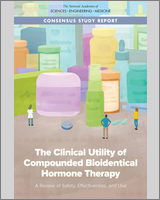NCBI Bookshelf. A service of the National Library of Medicine, National Institutes of Health.
The U.S. Food and Drug Administration (FDA) has approved dozens of hormone therapy products for men and women, including estrogen, progesterone, testosterone, and related compounds. These products have been reviewed for safety and efficacy and are indicated for treatment of symptoms resulting from hormonal changes associated with menopause or other endocrine-based disorders. In recent decades, an increasing number of health care providers and patients have turned to custom-formulated, or compounded, drug preparations as an alternative to FDA-approved drug products for hormone-related health concerns. These compounded hormone preparations are often marketed as “bioidentical” or “natural” and are commonly referred to as compounded bioidentical hormone therapy (cBHT). In light of the fast-growing popularity of cBHT preparations, the clinical utility of these compounded preparations is a substantial public health concern for various stakeholders, including medical practitioners, patients, health advocacy organizations, and federal and state public health agencies. This report examines the clinical utility and uses of cBHT drug preparations and reviews the available evidence that would support marketing claims of the safety and effectiveness of cBHT preparations. It also assesses whether the available evidence suggests that these preparations have clinical utility and safety profiles warranting their clinical use and identifies patient populations that might benefit from cBHT preparations in lieu of FDA-approved BHT.
Contents
- The National Academies of SCIENCES • ENGINEERING • MEDICINE
- COMMITTEE ON THE CLINICAL UTILITY OF TREATING PATIENTS WITH COMPOUNDED BIOIDENTICAL HORMONE REPLACEMENT THERAPY
- Reviewers
- Preface
- Acknowledgments
- Acronyms and Abbreviations
- Summary
- 1. Introduction
- 2. An Overview of Compounding
- 3. Regulatory Framework for Compounded Preparations
- 4. Reproductive Steroid Hormones: Synthesis, Structure, and Biochemistry
- 5. Compounded Bioidentical Hormone Preparations
- 6. Bioavailability of Compounded Bioidentical Hormone Therapy Preparations
- MEASURING CONCENTRATIONS OF STEROID HORMONES
- BIOANALYTICAL METHODS TO MEASURE THE BIOAVAILABILITY OF STEROID HORMONES
- BIOAVAILABILITY OF COMPOUNDED BIOIDENTICAL HORMONE THERAPY PREPARATIONS
- BIOAVAILABILITY OF TRADITIONALLY MANUFACTURED BIOIDENTICAL HORMONE THERAPY PRODUCTS
- CONCLUDING STATEMENTS
- REFERENCES
- 7. The Safety and Effectiveness of Compounded Bioidentical Hormone Therapy
- 8. The Use of Compounded Bioidentical Hormone Therapy
- 9. Clinical Utility and Recommendations
- Appendix A. Study Approach
- Appendix B. Study Methods
- Appendix C. Glossary
- Appendix D. Biosketches
- Appendix E. 503A and 503B Distribution Supplement
- Appendix F. Compounded Bioidentical Hormone Therapy Formulations with a Single Active Ingredient
- Appendix G. Compounded Bioidentical Hormone Therapy Formulations with Two or More Active Ingredients
- Appendix H. Boxed Warnings on U.S. Food and Drug Administration–Approved Estrogen and Testosterone Products
Suggested citation:
National Academies of Sciences, Engineering, and Medicine. 2020. The clinical utility of compounded bioidentical hormone therapy: A review of safety, effectiveness, and use. Washington, DC: The National Academies Press. https://doi.org/10.17226/25791.
Digital Object Identifier: https://doi.org/10.17226/25791
Library of Congress Control Number: 2020941544
Additional copies of this publication are available from the National Academies Press, 500 Fifth Street, NW, Keck 360, Washington, DC 20001; (800) 624-6242 or (202) 334-3313; http://www.nap.edu.
Printed in the United States of America
- NLM CatalogRelated NLM Catalog Entries
- Why women choose compounded bioidentical hormone therapy: lessons from a qualitative study of menopausal decision-making.[BMC Womens Health. 2017]Why women choose compounded bioidentical hormone therapy: lessons from a qualitative study of menopausal decision-making.Thompson JJ, Ritenbaugh C, Nichter M. BMC Womens Health. 2017 Oct 2; 17(1):97. Epub 2017 Oct 2.
- Safety and efficacy of compounded bioidentical hormone therapy (cBHT) in perimenopausal and postmenopausal women: a systematic review and meta-analysis of randomized controlled trials.[Menopause. 2022]Safety and efficacy of compounded bioidentical hormone therapy (cBHT) in perimenopausal and postmenopausal women: a systematic review and meta-analysis of randomized controlled trials.Liu Y, Yuan Y, Day AJ, Zhang W, John P, Ng DJ, Banov D. Menopause. 2022 Feb 14; 29(4):465-482. Epub 2022 Feb 14.
- Review Compounded bioidentical menopausal hormone therapy - a physician perspective.[Climacteric. 2021]Review Compounded bioidentical menopausal hormone therapy - a physician perspective.Stuenkel CA. Climacteric. 2021 Feb; 24(1):11-18. Epub 2020 Oct 19.
- Compounded Bioidentical Menopausal Hormone Therapy: ACOG Clinical Consensus No. 6.[Obstet Gynecol. 2023]Compounded Bioidentical Menopausal Hormone Therapy: ACOG Clinical Consensus No. 6.. Obstet Gynecol. 2023 Nov 1; 142(5):1266-1273.
- Review Bioidentical hormone therapy: a review of the evidence.[J Womens Health (Larchmt). 2007]Review Bioidentical hormone therapy: a review of the evidence.Cirigliano M. J Womens Health (Larchmt). 2007 Jun; 16(5):600-31.
- The Clinical Utility of Compounded Bioidentical Hormone TherapyThe Clinical Utility of Compounded Bioidentical Hormone Therapy
Your browsing activity is empty.
Activity recording is turned off.
See more...
